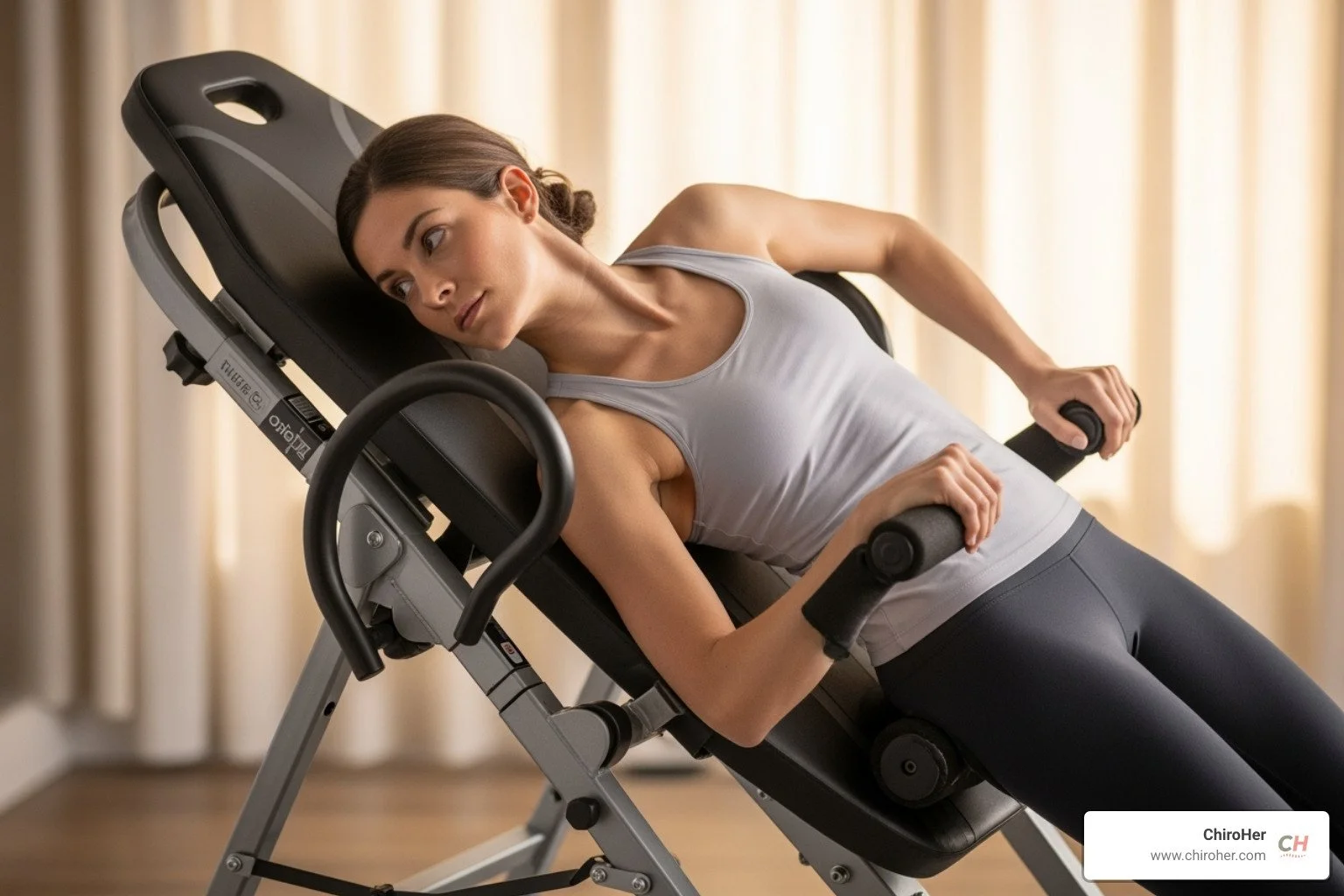Beyond the Hang: Top Inversion Table Exercises for Back Pain Relief
More Than Just Decompression
Many people use inversion tables for back pain relief, but these devices offer more than passive hanging. By performing exercises on an inversion table, you can actively strengthen your body and improve flexibility.
Common exercises include:
Inverted Crunches and Sit-ups
Inverted Squats and Back Extensions
Spinal Twists
Gentle Stretches for the hips, back, and neck
Hanging upside down helps decompress the spine, reducing pressure on nerves that cause discomfort. One study found that inversion at 60 degrees reduced back pain and improved flexibility over eight weeks. Another showed it helped many patients avoid surgery for disc compression.
I'm Dr. Michelle Andrews, founder of ChiroHer. I've helped many people, from expecting mothers to athletes, use exercises on an inversion table to improve mobility and find drug-free pain relief.
Your Guide to Effective Exercises on an Inversion Table
While inversion tables are great for passive decompression, they are also a platform for active exercise. Using gravity to your advantage, you can strengthen muscles, boost flexibility, and improve core strength in ways that traditional exercises can't match. This low-impact environment creates space between your vertebrae, taking pressure off nerves and making it beneficial for those with sciatica or herniated discs.
You can target a variety of muscle groups, including your core (abdominals, obliques), back (erector spinae), and legs (glutes, hamstrings, quadriceps). The reduced spinal compression makes movements more accessible and less stressful on your back compared to exercises on solid ground.
Before You Invert: Safety and Setup
Proper setup and adjustments:
Height Adjustment: Set the table about one inch taller than your height to find your center of gravity for smooth inversion.
Ankle Supports: Always ensure your ankles are securely fastened. Athletic shoes can provide extra cushioning.
Angle Selector Pin: Start with a low angle, like 15 or 30 degrees, to allow your body to adapt.
Listen to Your Body: Stop immediately if you feel any pain, dizziness, or discomfort.
Gradual starts are important. Keep initial sessions short (1–2 minutes) and slowly increase the duration and angle as you get comfortable. Consistency is more important than intensity.
A note on contraindications: Inversion is not for everyone. The position can increase blood pressure and eye pressure. Consult your healthcare provider before using an inversion table, especially if you have:
High blood pressure
Heart conditions or circulatory disorders
Glaucoma, a detached retina, or other eye diseases
Pregnancy
Osteoporosis
Herniated spinal discs (consultation is critical)
Unhealed fractures or joint problems
A history of stroke
As the Mayo Clinic wisely notes, "Inversion therapy is deemed unsafe for people with certain conditions." For more on natural pain relief, see our post on natural back pain relief.
Core Strengthening: The Best Exercises on an Inversion Table
Building a strong core is foundational for a healthy spine. An inversion table offers a unique way to work your abdominal muscles without the compressive forces of regular core workouts.
Inverted Crunches: Invert to a comfortable angle (20–60 degrees). Cross your arms over your chest or place hands behind your head without pulling on your neck. Use your abs to slowly crunch your upper body forward. The inversion angle adds resistance while decompressing your spine.
Inverted Oblique Crunches: From the crunch position, twist your torso to bring one elbow toward the opposite knee. Alternate sides to target your obliques.
Inverted Sit-ups: Lock the table at 90 degrees or full inversion. Contract your abs to lift your torso toward your knees, then lower slowly. This works a broad range of abdominal muscles and hip flexors without stressing your back.
These moves build core stability. For more ideas, check out our resources on therapeutic exercises.
Back and Leg Exercises on an Inversion Table for Support
An inversion table is also a great tool for strengthening your back and leg muscles, which are important for posture and stability.
Inverted Back Extensions: Invert to a 20–45 degree angle. With hands behind your head, arch your back slightly to lift your upper body. Squeeze your glutes and avoid momentum.
Inverted Squats: Invert to a moderate angle (30–60 degrees) and hold the support bars. Bend your knees as if doing a regular squat, keeping your back straight.
These exercises strengthen your posterior chain, helping maintain good posture and helping to prevent low back pain. If you struggle with sciatic pain, you may find our information on low back sciatic pain helpful.
Gentle Stretches for Flexibility and Relaxation
One of the most satisfying rewards of using an inversion table is the stretch and decompression it offers your spine and surrounding muscles.
Spinal Twists (Inverted Hip Rotations): At a 20–45 degree angle, hold the side bars and gently twist your upper body to one side, letting your hips rotate oppositely. Hold for 20–30 seconds and repeat on the other side.
Overhead Stretch: While inverted, extend your arms toward the floor to elongate your spine and lats.
Shoulder and Neck Stretches: Cradle your neck with your hands for light pressure or grab a support bar to decompress the shoulder joint.
These gentle movements ease tension and improve flexibility. For more on hands-on care, visit our section on manual therapy.
Maximizing Results and When to Seek Help
To get the most from your inversion practice, focus on consistency and gradual progression. An inversion table works best as part of a complete approach to spinal health.
How to Advance Your Inversion Practice
Start with minimal angles (20–30 degrees) and slowly increase to 45, 60, or even 90 degrees as you feel ready. Studies show that inversion at 60 degrees can be very effective for pain relief.
Begin with short sessions of 1–2 minutes. Several short sessions each day are better than one long session.
Always listen to your body. Never force an angle or duration that causes discomfort. For more details, see this study on inversion traction benefits.
When to See a Chiropractor
Your back pain persists or worsens despite regular inversion.
Nerve symptoms like sciatica do not improve.
You are unsure if inversion is safe for your health condition.
You want a personalized plan combining inversion with other therapies.
You hope to avoid surgery. One study showed 76.9 % of patients using inversion avoided surgery, compared to 22.2 % in the non-inversion group.
At ChiroHer, we provide patient-focused chiropractic care for women and prenatal clients. We can assess your spinal health and determine if an inversion table is right for you as part of a care plan that may include adjustments, acupuncture, and other wellness services.
Learn more about our approach to chiropractic care. If you're ready to see how chiropractic care combined with exercises on an inversion table can improve your well-being, we invite you to schedule a consultation with us today at our locations in Oklahoma City, Yukon, Edmond, Nichols Hills, Del City, Mustang, or Moore.
This guide is for informational purposes and is not a substitute for professional medical advice from your healthcare provider.





